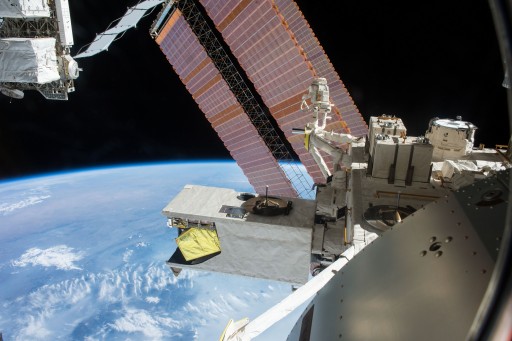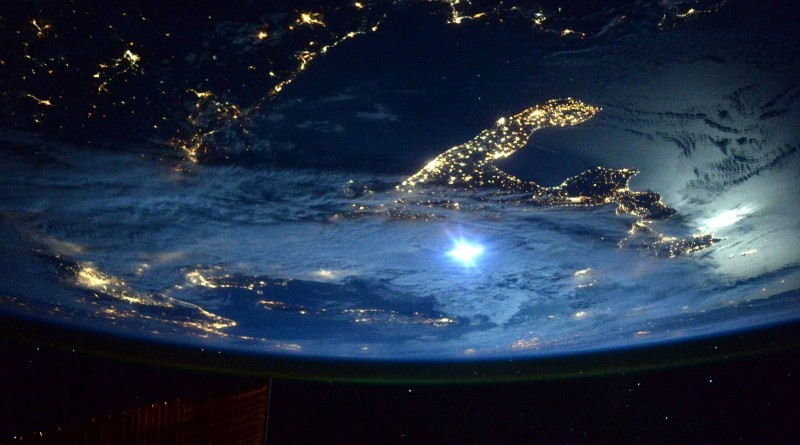ISS Operations Update – October 15, 2015

Experiments:
Plant Gravity Sensing [The experiment looks at gravity sensing in thale cress, a generic model used in many plant studies. As part of the experiment, the plant is cultivated in microgravity and artificial gravity using a centrifuge to determine changes on a cellular level that point to the mechanism of gravisensing with particular focus on calcium channel activation through the MCA-1 protein. An increase of calcium within the cytoplasm of plants is known to occur in response to stimuli such as phytohormones, temperature and touch the mechanism of which has been studied extensively on Earth. Whether a calcium increase also occurs as a result of gravistimulation remains to be seen as gravity is difficult to control for ground-based tests. The mechanisms of underlying biochemical reaction paths that lead to gravitropism are fully unknown. Recent studies point to a protein, MCA-1, and an actin cytoskeleton that are involved in the transport of calcium to create a directional response in the presence of gravity. The current hypothesis is that amyloplasts (starch containing particles) sediment in the direction of the gravity vector as a result of their high mass. This sedimentation causes tension stress in actin fibers thus activating the mechanosensitive calcium channels. Whether this system of channels and actin fibers also forms in microgravity is unknown.]
MagVector [The MagVector study is an interesting experiment that will expose a variable electrical conductor to Earth’s magnetic field to study the interaction between the conductor and the magnetic field in a range of different environments using extremely sensitive magnetic sensors installed around the conductor. The experiment will be installed in the European Drawer Rack that will provide a cooled vacuum to have the experiment take place in vacuum conditions. Earth’s magnetic field vector and overall field strength is measured in parallel to provide data for comparisons.]
SOLAR – ESA’s Solar investigation is completing an observation run from October 9 to 16, measuring the solar spectral irradiance and variability.
Journals [Electronic journals will be kept by the crew members to allow psychologists to study behavioral issues that are associated with the isolation and confinement over long-duration space missions. Journals from 6-month ISS mission have amounted to a total of 1,100 written pages, but no data beyond those six months is available making this an interesting opportunity to study the impact of isolation in the confinements of ISS over a longer period.]
Space Headaches Questionnaire [Answering a standard questionnaire, crew members provide data on the frequency and severity of space-environment-induced headaches to help in the development of methods to alleviate associated symptoms and improvement in the well-being and performance of crews.]
Ocular Health – Optical Coherence Tomography for measurement of retinal thickness, volume and nerve fiber layer [OH is a human physiology study. Its full name is Prospective Observational Study of Ocular Health in ISS Crews. “The Prospective Observational Study of Ocular Health in ISS Crews (Ocular Health) protocol aims to systematically gather physiological data to characterize the Risk of Microgravity-Induced Visual Impairment/Intracranial Pressure on crewmembers assigned to a 6 month ISS increment,” the NASA experiment overview said. It is known that some (not all) astronauts in orbit experience changes in visual acuity (visual clarity) and intraocular pressure as a result of fluid shifts within the body as it is subjected to microgravity. About 20% is astronauts flying to ISS have reported these kinds of changes. Test subjects will undergo pre-flight, flight and post-flight testing of their eyes using a variety of techniques.]
Seismoprognoz Data Download [Seismoprognoz will measure the temporal and spatial scales of ionospheric disturbances caused by seismic phenomena in order to develop algorithms to detect plasma features of earthquakes and anthropogenic impacts from space-based instruments. The payload consists of an external monoblock, a Data Control and Acquisition Module, an attachment kit, flash memory and associated cables and connectors.]
Study of cardiovascular system under graded physical load on VELO
Food Frequency Questionnaire
Calcium Study [This experiment looks at the causes of the loss of bone density in humans undergoing long duration space missions. It uses calcium phosphate and human bone samples to assess the solubility of calcium and bone in water in a zero-G environment.]
Maintenance/Systems:
Nominal Inspections/Servicing Tasks (Morning Inspection, Caution & Warning Panel Check, Sozh System Maintenance) (Russian Crew)
Photo Survey of Russian Segment Windows
Other Activities:
EVA Preparations – Lindgren & Kelly completed body measurements for suit resizing, they installed Rechargeable EVA Battery Assemblies (REBA) on EMUs #3003 & #3010 followed by checkouts of the EMU glove heaters and helmet cameras. Additionally, the gas trap of #3010 was replaced.
Private Psychological Conferences

